By Adam Hovorka
Managing Editor
X&O Labs
Twitter: @XOLabs_Editor
Note: In addition to his duties as Managing Editor of X&O Labs, Adam Hovorka also serves as an assistant coach at Plainedge High School (NY). Plainedge High School won the 2019 NY state championship.
We are a spread football team that wants to run the football teams using multiple formations and personnel groups. We will read almost everything in the run game and the inside zone is the foundation of our offense. Our inside zone allows us to attack the defense between the tackles, in the C gap and on the numbers. We feel this play gives us the ability to get our playmakers the ball in space. We also feel it is a play that will be effective vs both three man and four man front structured defenses. The play also allows us to be very multiple yet very simple. We have different tags that will change things for certain individuals and build our offense but keep things the same for the offensive line.
Our inside zone is a little different than typical zone read. First, our offensive line is looking for double teams and vertical push at the point of attack. Our offensive linemen are not all stepping the same direction but rather looking for double teams and movement. Some coaches refer to this concept as “Duo,” or two double team opportunities at the line of scrimmage.
Most inside zone teams have their offensive line all step the same direction as the play. If the play is IZ right the entire offensive line would step right and try to get horizontal movement. On our zone right our offensive line is looking format least two double teams vs a 4man front. The backside Tackle and Guard will be stepping toward the three tech tackle and the center and play side guard will both be stepping toward the one tech. In both cases the lineman want vertical push staying on the combination block until the backer commits.
Coaching Points:
Our aiming point for the back is the play-side hip of the center.
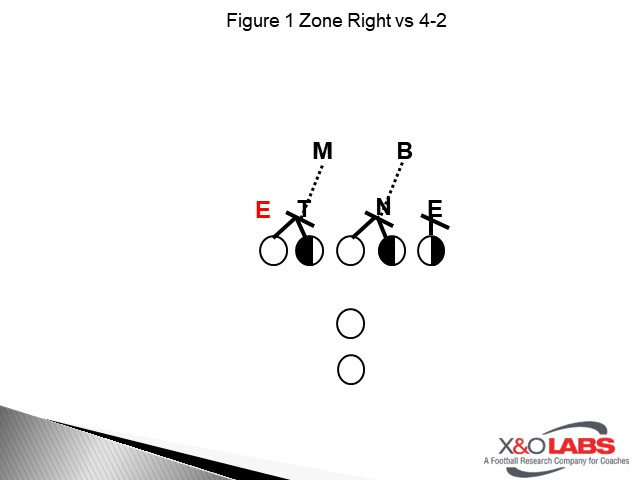
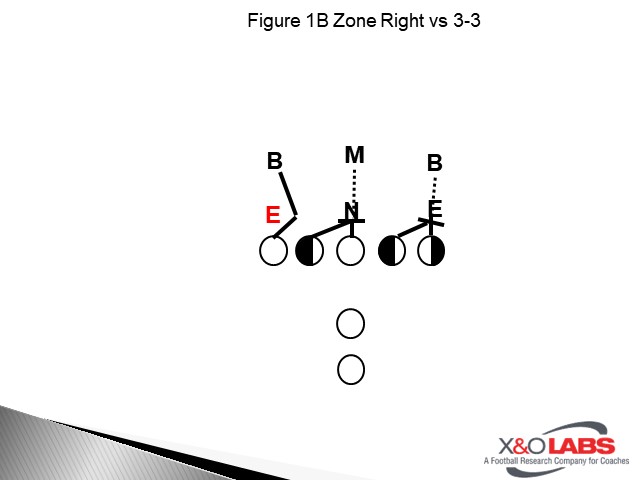
Our back is told to bang it in up there or cut back behind the player who was the initial read. We call that bending it back and feel this where we have the best success with the play.
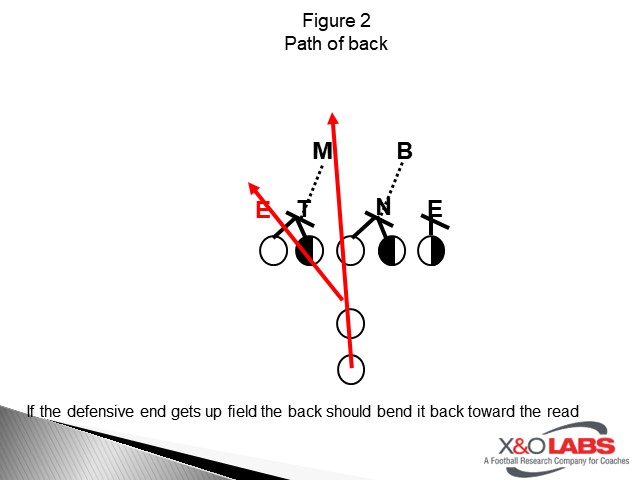
Our mindset with this play is more old-school inside veer getting downhill right away. Our back, whether he is in pistol or aligned on the side, will have his shoulders square to the LOS and be ready to attack downhill right now. We feel this quickness of the downhill action makes the read easier for the QB because the defensive end has to declare what he is doing right away.
Our first variation for our inside zone is attaching the option after the QB’s initial give or pull read. We can do this from a two-back formation or have the slot be the pitch with an easy motion.
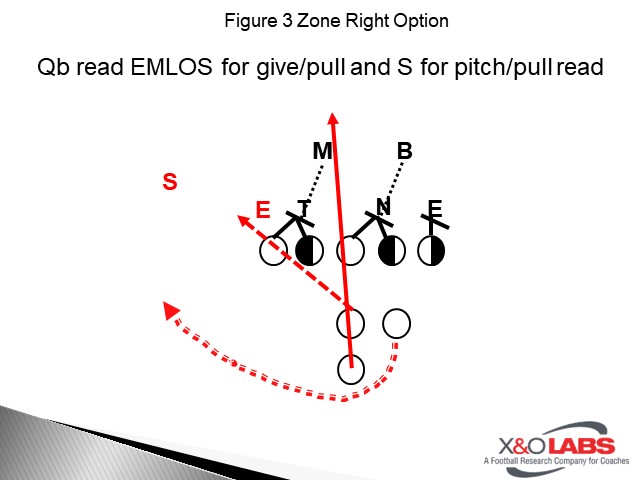
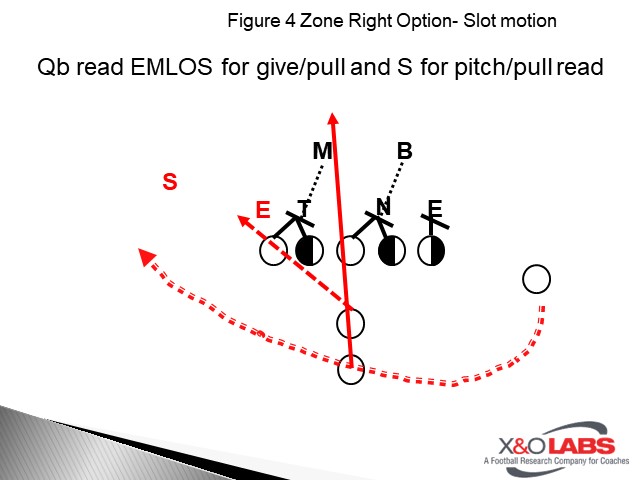
We do this as a way to force defenses to play sound assignment football. This enables us to have an opportunity to get our playmakers the ball in space. We also like the idea of having our slot WR's not always having to block the outside backer types. Now, instead of blocking them we can pitch off that backer and always make him wrong.
Our next variation has become a staple of our offense and has created many big plays for us. Instead of having a pitch player we can just tag a bubble as the third option instead of pitch.
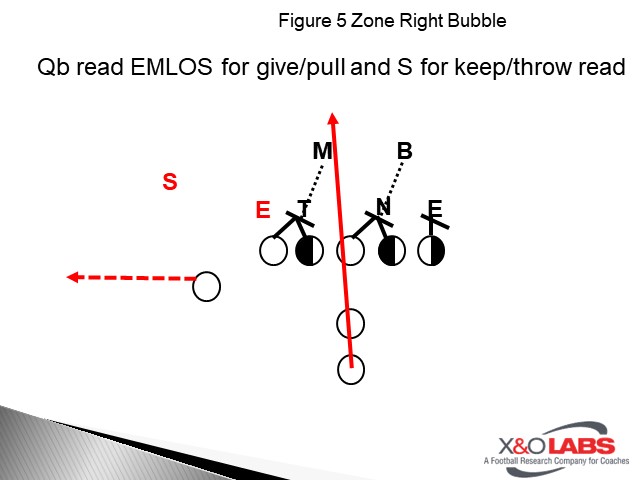
It is also a pre-snap read for the QB and receiver running the bubble. This forces teams to play a little closer on our slots thus creating some more room for the QB on pull reads. We like this variation as it now forces teams to defend the entire width of the football field and one missed tackle can be a big play. Coaches, in our bubble we have the slot backpedal and show his chest to the quarterback. We just feel this is a much easier throw for the QB to make while he is one the move and often has a defender in his face.
There will be times when we just want to give the ball and eliminate the read part of the play. Here we just have an H-back or TE type line up in an H-Back position and come across the formation and block the read.
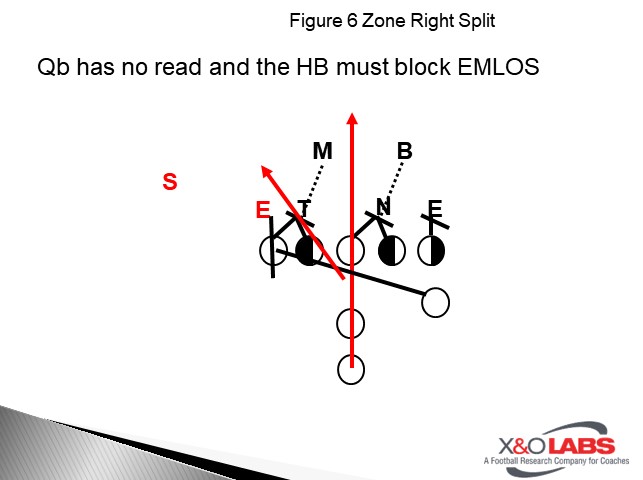
This is your
Managing Editor
X&O Labs
Twitter: @XOLabs_Editor
Note: In addition to his duties as Managing Editor of X&O Labs, Adam Hovorka also serves as an assistant coach at Plainedge High School (NY). Plainedge High School won the 2019 NY state championship.
We are a spread football team that wants to run the football teams using multiple formations and personnel groups. We will read almost everything in the run game and the inside zone is the foundation of our offense. Our inside zone allows us to attack the defense between the tackles, in the C gap and on the numbers. We feel this play gives us the ability to get our playmakers the ball in space. We also feel it is a play that will be effective vs both three man and four man front structured defenses. The play also allows us to be very multiple yet very simple. We have different tags that will change things for certain individuals and build our offense but keep things the same for the offensive line.
Our inside zone is a little different than typical zone read. First, our offensive line is looking for double teams and vertical push at the point of attack. Our offensive linemen are not all stepping the same direction but rather looking for double teams and movement. Some coaches refer to this concept as “Duo,” or two double team opportunities at the line of scrimmage.
Most inside zone teams have their offensive line all step the same direction as the play. If the play is IZ right the entire offensive line would step right and try to get horizontal movement. On our zone right our offensive line is looking format least two double teams vs a 4man front. The backside Tackle and Guard will be stepping toward the three tech tackle and the center and play side guard will both be stepping toward the one tech. In both cases the lineman want vertical push staying on the combination block until the backer commits.
Coaching Points:
- Your Offensive Line has to work combination blocks every day! We want movement on that first level and tell our guys to stay on that first level until the LB starts coming downhill.
- Coaching the quarterback and running back in a live read period every day is another must. Coaches, you should start as the defensive player being read so you can see the quarterback’s eyes and makes sure he is looking where you want him to be looking. As you add the triple part of the play, the read needs have a ball in his hand as the read. On any give read, you as the read player flip the ball to the qb so he can carry out the next phase of the play.
- We don’t over complicate the mesh portion of the read. We tell the QB he is responsible for the decisions. When we have a QB who we want with the ball, we tell him if the read would tackle him then pull the ball. Years when our back is the guy we want with the ball; we tell the qb to give unless the read is going to tackle the back.
- Centers have to be part of the mesh period and work in pre-practice on snaps and timing.
- Coaches you must give the qb tough some fast reads for teams that blitz off the edge.
- We would never use all these variations in a given game or maybe in a given season. Match-up what you have personnel wise to what your quarterback can handle mentally.
Our aiming point for the back is the play-side hip of the center.


Our back is told to bang it in up there or cut back behind the player who was the initial read. We call that bending it back and feel this where we have the best success with the play.

Our mindset with this play is more old-school inside veer getting downhill right away. Our back, whether he is in pistol or aligned on the side, will have his shoulders square to the LOS and be ready to attack downhill right now. We feel this quickness of the downhill action makes the read easier for the QB because the defensive end has to declare what he is doing right away.
Our first variation for our inside zone is attaching the option after the QB’s initial give or pull read. We can do this from a two-back formation or have the slot be the pitch with an easy motion.


We do this as a way to force defenses to play sound assignment football. This enables us to have an opportunity to get our playmakers the ball in space. We also like the idea of having our slot WR's not always having to block the outside backer types. Now, instead of blocking them we can pitch off that backer and always make him wrong.
Our next variation has become a staple of our offense and has created many big plays for us. Instead of having a pitch player we can just tag a bubble as the third option instead of pitch.

It is also a pre-snap read for the QB and receiver running the bubble. This forces teams to play a little closer on our slots thus creating some more room for the QB on pull reads. We like this variation as it now forces teams to defend the entire width of the football field and one missed tackle can be a big play. Coaches, in our bubble we have the slot backpedal and show his chest to the quarterback. We just feel this is a much easier throw for the QB to make while he is one the move and often has a defender in his face.
There will be times when we just want to give the ball and eliminate the read part of the play. Here we just have an H-back or TE type line up in an H-Back position and come across the formation and block the read.

This is your









